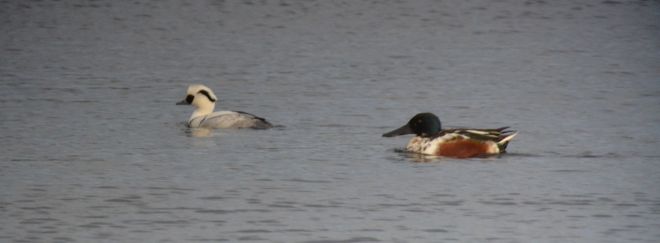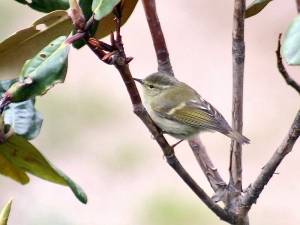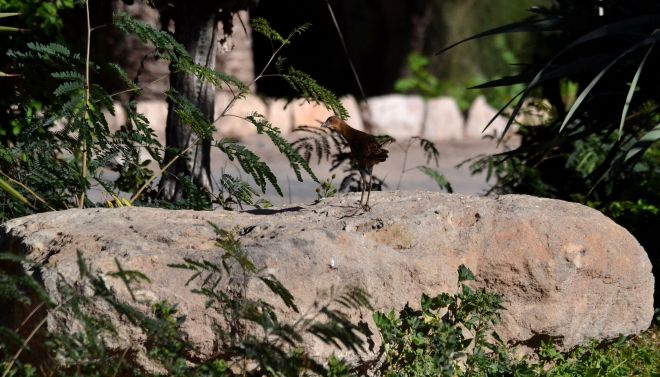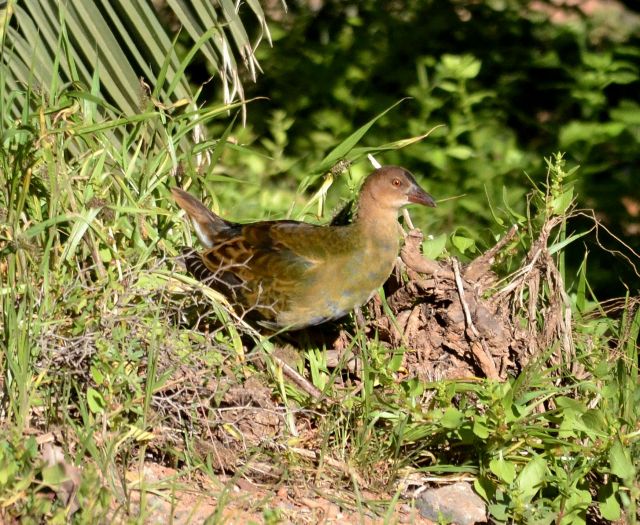This mini-break was my third visit to Fuerteventura. I came here previously in February 2015 for five days (see trip reports), then in December 2017 just for a weekend to twitch a Dwarf Bittern, possibly the desert island’s most renowned avian resident. I was one of the earlier Brits and first Oxon birder to go for what was then the fifth Westpal record. But the urgency of that madcap adventure was not in the end necessary as this celebrity has remained faithful to it’s adopted home to the north-west of Rosario and Fvta airport ever since. Experiencing the bird again was an important aim for this new trip.
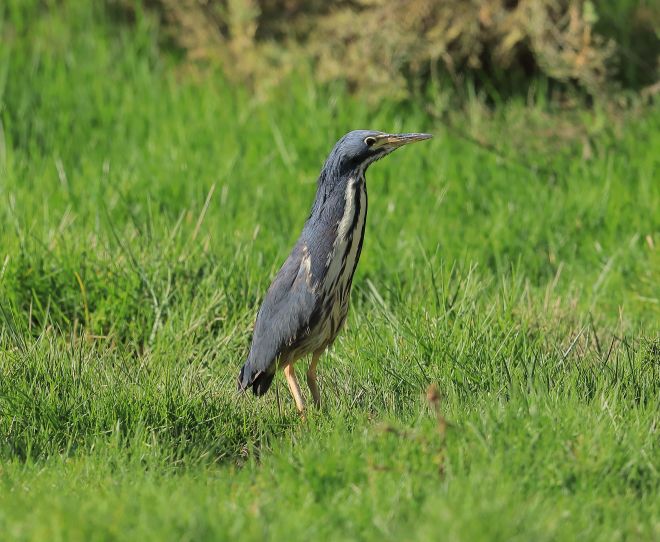
Dwarf Bittern (adult male) at Barranco de Rio Cabras © and courtesy of Lars Theng
So Thursday morning (10th) found me driving out through the rugged though languid grandeur of the Fvta landscape heading for Barranco de Rio Cabras, the Bittern site. This river gorge runs close by an access road to a waste recycling plant off the FV20 main road. An approximate GPS from which to start searching for the DB is N28.4758′ W13.9030′. There I met two birders from Sweden who were unsure exactly where to look, so I took them out to the spot where I was successful those 13 months ago (see here).
As we walked across the stony plain from the road out to the Barranco the air overhead contained around nine Egyptian Vulture. This is a reliable location to find that raptor since they are attracted by the waste recycling plant. As we reached the gorge a similar number of Spoonbill flew out from it and circled around, the first I have seen here. Then we crossed the Barranco to watch for the Bittern in an area between two dams that it frequents regularly.

Cliff-face Hoopoe

Cliff-top Ruddy Shelduck
Barrancos such as this containing water in places act as a magnet for birds. Some of the more noticeable ones moving up and down on this occasion were Little Egret, Black-winged Stilt, Ruddy Shelduck, Little-ringed Plover and Common Snipe. A Hoopoe was active on the opposite cliff face, while Raven seemed omni-present overhead. After a while one of my companions went to search further downstream while the other remained with me.
When the call came to say the Dwarf Bittern had been located around 500 metres away the ensuing dash to connect was seriously off-piste. I could not keep up with Lars who had 20 years on me, and as I had seen the bird before it didn’t seem worth breaking an ankle or otherwise going arse over tit for. In the event I took just the one tumble, suffering no more than a bruised finger. None of this now is as easy as it used to be when I started birding abroad eight years ago.
Upon reaching the spot where the others were sitting, in a green and watery area of the barranco floor, the DB had gone back into cover. They had watched it feeding very closely and Lars had good images on his big lens HD camera. A tense wait then ensued without the bird re-emerging before my companions, being satisfied with their experience decided to move on. But as soon as they left I beheld the Dwarf Bittern striding out of cover again a little upstream from where I was sitting.
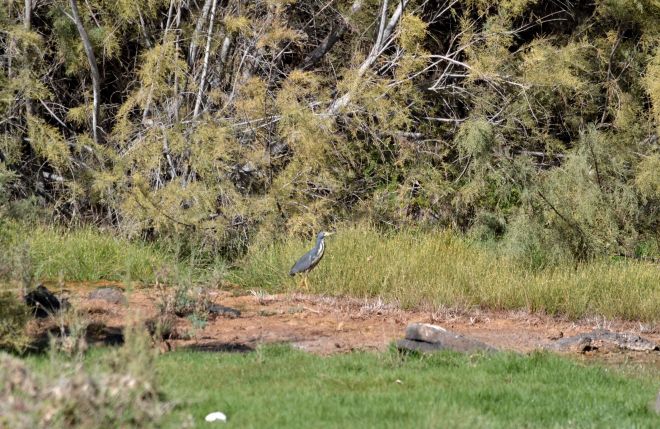
“Hello old friend … what have you been doing since we last met?”
Now this famous and iconic lone wanderer gave itself up to my camera for the second time. It was a rather more tranquil setting than the place upstream where I had observed the bird previously. And unlike then I was now completely alone with it and so able to enjoy especially meaningful communion. I watched and took pictures as the DB foraged along the water’s edge, practising it’s repertoire of Heron poses as it went and moving gradually upstream.

Dwarf Bittern (all pictures)
Though the habitat here clearly caters for this adult male’s sustenance I pondered upon what else might keep it in this adopted home: far from the usual range, away from his own kind and without a mate. Maybe there were similarities between us in these moments at the back of beyond. Whether or not such vagrants eventually return home is something I have thought over many times. Or do they either just settle where they have strayed, or as is more often the case die fairly soon? Might this solo Dwarf Bittern just have a low libido or could it be escaping a troubled relationship history? Perhaps I should stop there.
From close to where I was now a track led up the gorge side to the plain above, so the walk back to my car was much easier than the outward one. It now being early afternoon plenty of time remained to re-visit the lower end of Barranco de Rio Cabras where most of Fvta’s regular small passerines may be encountered. This is accessed via a dirt track from Playa Blanca, just off the FV2 road immediately south of Puerto del Rosario.

Spectacled Warbler

Fuerteventura Chat (fem)
Retracing a route I first trod in 2015, the first small birds I came across were some Spectacled Warbler (pictured above, left). And in amongst them were at least two Fuerteventura Chat (above, right), an island endemic without seeing which no visit here would be complete. A little further along two Trumpeter Finch landed just ahead of me but I could not get pictures before they went on their way. What were probably Berthelot’s Pipit and Lesser Short-toed Lark were buzzing about the arid habitat, being much more frequently heard than seen. And inevitably there were Spanish Sparrows.
Once I reached the barranco’s lowest dam, the height of water behind made it impossible to walk on north-west to the Dwarf Bittern site. Things seemed far less birdy here than in 2015, and so instead I took some time to pay attention to the remote location’s insect life. Odonata comprised Blue Emperor, Red-veined Darter, Broad Scarlet and Sahara Bluetail; the last of those being Fvta’s only damselfly. And as in other locations this week there were a lot of dark brown-toned Pyrausta moths.

Broad Scarlet (male)

Broad Scarlet (female)

Sahara Bluetail

Sahara Bluetail
Butterflies were represented by the same five polyvoltine species (all-year flyers) that I encountered throughout this trip: Painted Lady, Red Admiral, Clouded Yellow, Small White and African Grass Blue; the last of those being a welcome lifer. Everywhere I went I was impressed by the significant size variation in Painted Lady. All were smaller than the migrants that regularly reach Great Britain, but I wondered if the smallest of all were an endemic form. Having read things up that is not so. There is a second Painted Lady species in the Canaries but I did not find any of them. So I must assume the size of adult butterflies depends on how much individual larvae find to eat in this arid region.

Painted Lady (all pictures)
The trip lifer, African Grass Blue (pictured below) is one of the tiniest Blue species that is widespread and often common across much of north Africa and the Middle East, but extends into parts of southern Europe as well. It is discreet and very low flying, particularly favouring coastal localities in which irrigation maintains vegetation; but is also frequent in hot, dry habitats such as here. I also noticed this butterfly in the forest strip in Costa Calma while staking out the Allen’s Gallinule there.

African Grass Blue (all pictures)

African Grass Blue

African Grass Blue
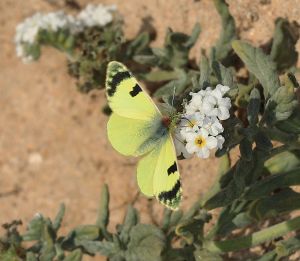
Greenish Blacktip © and courtesy of Lars Theng
On the walk back I crossed paths with a few Greenish Blacktip (pictured above), another common north African butterfly that I had seen lots of in 2015 though most then were very worn. Like Orange Tip at home this restless and fast flying species is difficult to get pictures of. Tired from my day long exertions I couldn’t summon the energy to chase them across the rocky ground this time and so publishing my own images of GBT will have to wait.

Houbara Bustards on Tindaya Plain © and courtesy of Lars Theng (all pictures)
On Friday morning (11th) I couldn’t resist going again for Houbara Bustard on Tindaya Plain in Fvta’s north-east. On both my previous trips I had seen those local specialities further to the north nearer El Cotillo, but this time I opted for where most of the images published online come from. Arriving at first light I eventually observed three Houbaras in flight, and then another more distantly, but there were no roadside encounters such as I sought. That was rather annoying, especially as my Swedish associates of the previous day had photographed displaying males at 50 metres here (pictured above).
This slideshow requires JavaScript.
After two hours of frustration I decided to drive north along the dirt road to El Cotillo, but ended up circuiting the north side of Mount Tindaya back to the main road from EC to La Oliva instead. The route I intended now appears to be blocked by a private open cast mining site. Though some of the vistas here were well worth the detour the overriding sentiment was of disappointment over the lack of Houbaras, so I continued on to La Oliva to refresh my spirits. This village is rather like an oasis in the desert and unusually wild flower rich for this island, and so once again my attention turned to butterflies.
There must be trillions of Painted Lady in Fuerteventura and here it would not be an exaggeration to say the waste ground I now walked around shimmered with them. This all rather put into context the occasional spectacular irruptions that occur at home, such as one around 10 years ago. But the mind simply boggles at how many trillions of trillion there must be across the species’ entire range. The images I saved from La Oliva are all of Clouded Yellow, of which these (below) are the most pleasing.

Clouded Yellow (all pictures)
Unfortunately on this trip my laptop charger failed and so I lost contact with Canary Islands RBA. It wasn’t until Friday evening I got a message from Eduardo saying a Desert Wheatear had been rediscovered at the reservoir site of Las Molinos that I drove past on my way back to Costa Calma. So missing what could have been my second record of that bird was also a little disappointing. It remains to present a few other and random bird images (below) from the three days featured in these two posts..

Berthelot’s Pipit at La Oliva

Cattle Egret at Costa Calma

North African Raven on Tindaya plain

Egyptian Vulture
So returning to my original question, was this retro-tripette truly motivating? Where the star attractions of Allen’s Gallinule and Dwarf Bittern were concerned the answer is a most definite yes. But revisiting places for no particular reason did not grab my imagination quite so much. Possibly that is because there is only one habitat on Fuerteventura – rough, dry and very stony – in which it is always difficult to pick birds out. But despite slightly anxious doubts in the days leading up to departure, once I got off the plane all the tension slipped away and I was well and truly back into overseas wildlife travel mode. Next up will be Agadir II in February, also through lastminute.com. I might as well do all this while I can.
